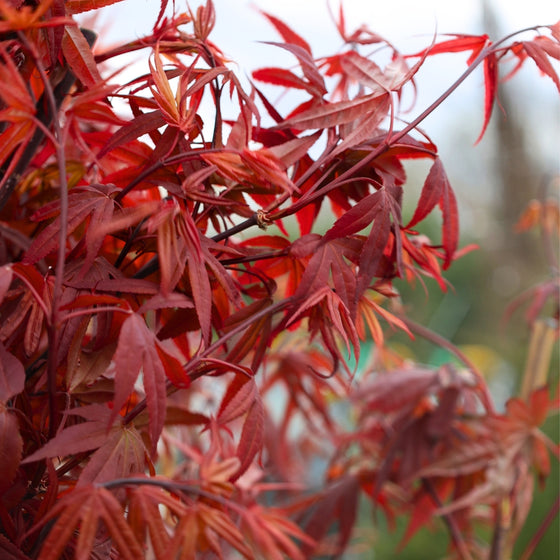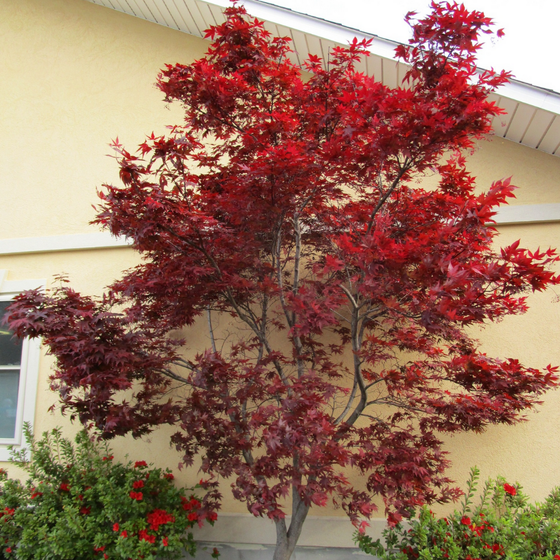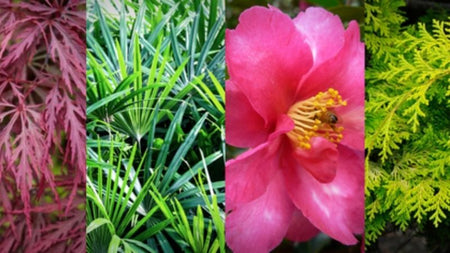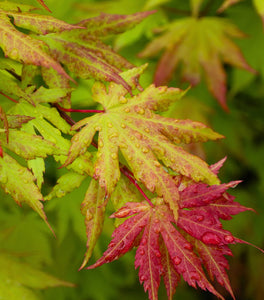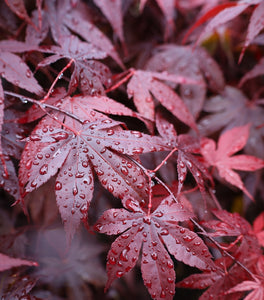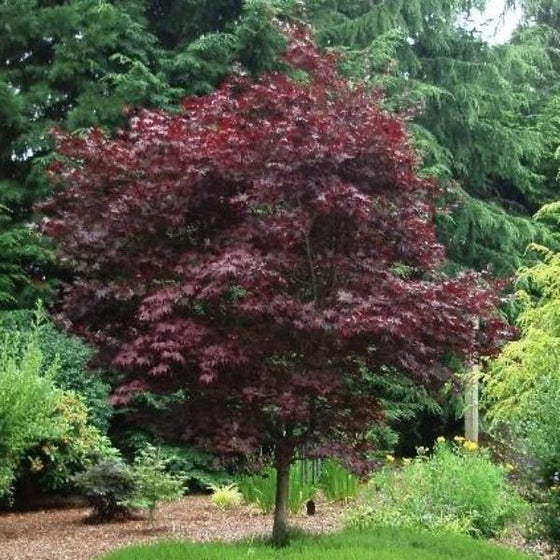
Images Depict Mature Plants
Emperor Japanese Maple
Emperor Japanese Maple (Acer palmatum ‘Emperor I’) is a stunning ornamental tree prized for its rich burgundy-red foliage, elegant structure, and exceptional hardiness. Emerging in spring with vibrant, deep red leaves, the foliage holds its color brilliantly throughout the summer before transforming into fiery crimson shades in the fall. Growing to a graceful 15 to 20 feet tall and wide, the Emperor Japanese Maple has a beautiful, upright form that makes it a striking focal point in gardens, courtyards, and landscape borders.
One of the standout features of the Emperor Japanese Maple is its improved hardiness and later leafing habit compared to other red-leaf Japanese maples. This late leaf-out helps protect the tender spring foliage from frost damage, making it a more reliable performer in cooler climates. Thriving in partial shade to full sun (with some protection from hot afternoon sun in warmer zones), it prefers rich, well-drained soil and benefits from a layer of mulch to keep roots cool and moist. Once established, it is low-maintenance and drought-tolerant, requiring only occasional watering during dry spells.
Perfect for use as a specimen tree, in woodland gardens, or even as a large patio container plant, the Emperor Japanese Maple brings year-round interest and timeless elegance to the landscape. Its striking color, refined shape, and resilience to changing seasons make it an excellent choice for gardeners seeking a beautiful, easy-care tree with four-season appeal. Whether you’re designing a serene Japanese-style garden or enhancing a contemporary landscape, Emperor I adds unmatched beauty, texture, and vibrant color to any outdoor space.
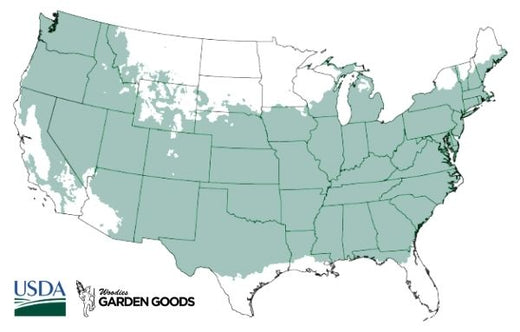
| Hardiness Zone: | 5 - 8 |
|---|---|
| Mature Height: | 15 Feet |
| Mature Width: | 15 Feet |
| Classification: | Small tree |
| Sunlight: | Full sun to part shade |
| Habit: | Deciduous, rounded |
| Foliage: | Dark red foliage that turns scarlet in fall |
| Soil Condition: | Any well drained soil |
| Water Require: | Water regularly |
| Uses: | Extremely attractive when used as a focal point or a specimen planting |
How to Care for Emperor Japanese Maple
Before you buy an Emperor Japanese Maple, make sure to read about the care instructions that are recommended to keep this plant healthy and thriving.
How Do I Plant an Emperor Japanese Maple Tree?
To plant an Emperor Japanese Maple tree successfully, start by selecting a location with partial shade to full sun, preferably with some afternoon shade in hotter climates to protect the delicate foliage. The soil should be rich, well-drained, and slightly acidic to neutral in pH. Dig a hole twice as wide and just as deep as the root ball to allow the roots to spread easily. Gently loosen the roots before placing the tree in the hole, ensuring the top of the root ball sits level with or slightly above the surrounding soil. Backfill with a mix of native soil and compost, and water deeply to settle the soil around the roots. After planting your Emperor Japanese Maple, apply a 2- to 3-inch layer of mulch around the base to conserve moisture, suppress weeds, and keep the root zone cool. Be sure to keep the mulch a few inches away from the trunk to prevent rot. Water the tree regularly during the first growing season, especially during dry spells, to help it establish a strong root system. With proper planting and care, your Emperor Japanese Maple will develop into a stunning centerpiece, offering vibrant burgundy foliage in spring and summer and a brilliant crimson display in the fall, enhancing any landscape with year-round elegance.
How should I water my Emperor Japanese Maple?
Watering your Emperor Japanese Maple properly is essential for promoting healthy root development, vibrant foliage, and strong overall growth. During the first year after planting, water deeply two to three times per week, ensuring the soil stays consistently moist but never waterlogged. Focus on slow, deep watering at the base of the tree rather than frequent shallow watering, which encourages weak, surface-level roots. Using a soaker hose or drip irrigation system helps deliver steady moisture directly to the root zone without splashing water onto the foliage, which can reduce the risk of fungal diseases. Once established, Emperor Japanese Maple trees are moderately drought-tolerant but will benefit from supplemental watering during hot, dry periods—especially in the summer months. Always check the top few inches of soil; if it feels dry, it's time to water. Mulching with organic material like shredded bark or compost can help retain soil moisture, regulate temperature, and reduce evaporation. Proper watering not only supports the tree’s elegant form and deep burgundy color through the growing season but also strengthens its resilience to heat stress, ensuring your Emperor Japanese Maple remains a stunning focal point year after year.
How should I fertilize my Emperor Japanese Maple Tree?
Fertilizing your Emperor Japanese Maple tree properly helps maintain its rich burgundy foliage, strong structure, and vibrant seasonal color. In early spring, just as new growth begins to emerge, apply a slow-release, balanced fertilizer such as a 10-10-10 or a formula specifically designed for trees and shrubs. Spread the fertilizer evenly around the drip line of the tree, keeping it several inches away from the trunk, and water thoroughly to help the nutrients penetrate the soil. Avoid high-nitrogen fertilizers, as they can encourage excessive leafy growth at the expense of the tree’s natural shape and color intensity. For established Emperor Japanese Maple trees, a single application of fertilizer in early spring is usually sufficient to support healthy growth throughout the season. If your soil is particularly poor or sandy, you may supplement with a second light feeding in mid-summer. Organic options such as composted leaf mulch or well-aged manure can also be used to enrich the soil naturally while maintaining the tree’s preferred slightly acidic conditions. With a careful, moderate fertilization routine, your Emperor Japanese Maple will continue to thrive, delivering stunning color displays and graceful beauty year after year in your landscape.

How and When should I prune my Emperor Japanese Maple?
Pruning your Emperor Japanese Maple should be done carefully to maintain its elegant, natural form and enhance air circulation and sunlight penetration. The best time to prune is in late winter to early spring, just before the new growth begins but after the risk of severe frost has passed. Begin by removing any dead, damaged, or crossing branches using clean, sharp pruning shears. Focus on thinning crowded areas rather than heavy shaping, as light, selective pruning preserves the tree's graceful structure. Always make cuts just above a leaf node or branch junction to encourage healthy regrowth. Minor touch-up pruning can also be done in mid-summer once the leaves have fully developed, allowing you to better see the tree’s shape. Avoid heavy pruning in late summer or fall, as this can stimulate tender new growth that may not harden off before winter. Maintaining your Emperor Japanese Maple with careful seasonal pruning will encourage strong branch structure, improve airflow, and help prevent disease. With the right timing and technique, your maple will continue to be a stunning focal point, showcasing vibrant burgundy foliage in spring and summer and brilliant crimson color in the fall.


